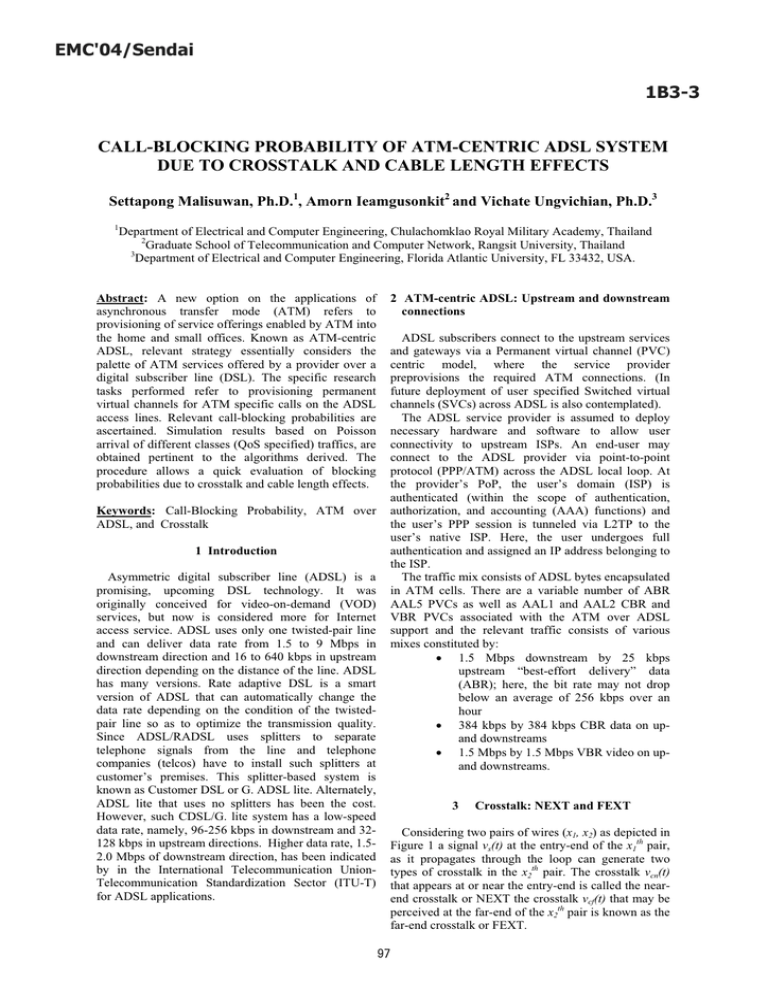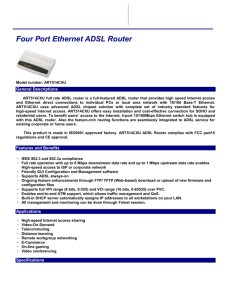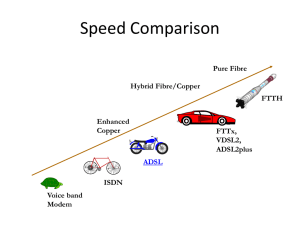Full Text:PDF
advertisement

CALL-BLOCKING PROBABILITY OF ATM-CENTRIC ADSL SYSTEM
DUE TO CROSSTALK AND CABLE LENGTH EFFECTS
Settapong Malisuwan, Ph.D.1, Amorn Ieamgusonkit2 and Vichate Ungvichian, Ph.D.3
1
Department of Electrical and Computer Engineering, Chulachomklao Royal Military Academy, Thailand
2
Graduate School of Telecommunication and Computer Network, Rangsit University, Thailand
3
Department of Electrical and Computer Engineering, Florida Atlantic University, FL 33432, USA.
Abstract: A new option on the applications of
asynchronous transfer mode (ATM) refers to
provisioning of service offerings enabled by ATM into
the home and small offices. Known as ATM-centric
ADSL, relevant strategy essentially considers the
palette of ATM services offered by a provider over a
digital subscriber line (DSL). The specific research
tasks performed refer to provisioning permanent
virtual channels for ATM specific calls on the ADSL
access lines. Relevant call-blocking probabilities are
ascertained. Simulation results based on Poisson
arrival of different classes (QoS specified) traffics, are
obtained pertinent to the algorithms derived. The
procedure allows a quick evaluation of blocking
probabilities due to crosstalk and cable length effects.
Keywords: Call-Blocking Probability, ATM over
ADSL, and Crosstalk
1 Introduction
Asymmetric digital subscriber line (ADSL) is a
promising, upcoming DSL technology. It was
originally conceived for video-on-demand (VOD)
services, but now is considered more for Internet
access service. ADSL uses only one twisted-pair line
and can deliver data rate from 1.5 to 9 Mbps in
downstream direction and 16 to 640 kbps in upstream
direction depending on the distance of the line. ADSL
has many versions. Rate adaptive DSL is a smart
version of ADSL that can automatically change the
data rate depending on the condition of the twistedpair line so as to optimize the transmission quality.
Since ADSL/RADSL uses splitters to separate
telephone signals from the line and telephone
companies (telcos) have to install such splitters at
customer’s premises. This splitter-based system is
known as Customer DSL or G. ADSL lite. Alternately,
ADSL lite that uses no splitters has been the cost.
However, such CDSL/G. lite system has a low-speed
data rate, namely, 96-256 kbps in downstream and 32128 kbps in upstream directions. Higher data rate, 1.52.0 Mbps of downstream direction, has been indicated
by in the International Telecommunication UnionTelecommunication Standardization Sector (ITU-T)
for ADSL applications.
2 ATM-centric ADSL: Upstream and downstream
connections
ADSL subscribers connect to the upstream services
and gateways via a Permanent virtual channel (PVC)
centric model, where the service provider
preprovisions the required ATM connections. (In
future deployment of user specified Switched virtual
channels (SVCs) across ADSL is also contemplated).
The ADSL service provider is assumed to deploy
necessary hardware and software to allow user
connectivity to upstream ISPs. An end-user may
connect to the ADSL provider via point-to-point
protocol (PPP/ATM) across the ADSL local loop. At
the provider’s PoP, the user’s domain (ISP) is
authenticated (within the scope of authentication,
authorization, and accounting (AAA) functions) and
the user’s PPP session is tunneled via L2TP to the
user’s native ISP. Here, the user undergoes full
authentication and assigned an IP address belonging to
the ISP.
The traffic mix consists of ADSL bytes encapsulated
in ATM cells. There are a variable number of ABR
AAL5 PVCs as well as AAL1 and AAL2 CBR and
VBR PVCs associated with the ATM over ADSL
support and the relevant traffic consists of various
mixes constituted by:
x 1.5 Mbps downstream by 25 kbps
upstream “best-effort delivery” data
(ABR); here, the bit rate may not drop
below an average of 256 kbps over an
hour
x 384 kbps by 384 kbps CBR data on upand downstreams
x 1.5 Mbps by 1.5 Mbps VBR video on upand downstreams.
3
Crosstalk: NEXT and FEXT
Considering two pairs of wires (x1, x2) as depicted in
Figure 1 a signal vs(t) at the entry-end of the x1th pair,
as it propagates through the loop can generate two
types of crosstalk in the x2th pair. The crosstalk vcn(t)
that appears at or near the entry-end is called the nearend crosstalk or NEXT the crosstalk vcf(t) that may be
perceived at the far-end of the x2th pair is known as the
far-end crosstalk or FEXT.
4 Twisted-Pair Channel Modeling
vs(t)
x1th pair
Near- end
x2th pair
vcn(t)
The twisted-pair telephone loop transmission
channel modeling plays an important role in evaluating
the subchannel allocation performance of the ADSL
system. In the relevant channel modeling, a copper
loop can be assumed to be perfectly terminated with its
characteristic impedance. The corresponding transfer
function of the loop for a signal at a frequency f over a
line length d is given by [1]:
Far-end
vcf(t)
Entry
Figure 1
NEXT and FEXT.
In the presence of NEXT, the SNR of jth pair can be
defined as the ratio between the power spectral density
(psd) of the signal level in the jth pair to the psd of the
additive interference vcn(t). In reference to the entryend, the signal-to-interfering near-end crosstalk noise
ration SNRn is given by [1]
SNRn(d, f) = exp[-2dĮ(f)]/xf 3/2
(1)
Where d is the small distance from the entry-end at
which the NEXT is measured, Į(f) is the frequencydependent attenuation factor, f is the frequency and x
is a random variable, which is the function of the
distributed jth pair under consideration. Typically, for a
24 gauge cable, the value of x § 1.4x10-9. Similar
considerations on FEXT leads to an SNR parameter
given by [1].
1
(2)
SNR F (d, f )
\f 2 d
Where ȥ is another random variable, which is a
function of the distributed part under consideration:
Typically, ȥ § 10-10 [1].
The ADSL provides essentially a simple operation
(at 1.5 Mbps) from a CO to the subscriber location. In
this context, FEXT may become the dominant
crosstalk inasmuch as, the received signal strength at
the subscriber end could be low as result of attenuation
if suffered along the loop; (and hence is prone to
FEXT). Therefore, the potential interference in ADSL
is assumed to stem from the FEXT plus other additive
gaussian noise (AWGN) of the system. By including
these background noise power density considerations,
the total interference component at the jth subchannel
can, therefore, be written as [1]:
SNRj,Total (in Db) = SNRF,j (in Db) + SNRAWGN (in Db)
(3a)
SNR j,Total
(3b)
1
2
\ ( j u BW j ) 2 u d V 2 D(f )d
e
P
where \ is a random variable. Typically, \ | 1010 [2].
P and V2 are input signal power and AWGN power
respectively. D(f) is an attenuation function of twistedpair cable.
H(d, f ) e d ( k1
f k 2 f ) jdk3f
e
(4)
Here, d, namely, the length of the loop is specified
in units of mile, and f is in Hz. Further, k1, k2, and k3
are constant parameters depending on the gauge of
cable. Table 2.8 shows typical values of k1, k2, and k3
for different gauge of twisted pairs. [1]
Table 1. Parameters for a Twisted Pair Cable Model.
Gauge
k1 (x10-3)
k2 (x10-8)
k3 (x10-5)
22
3.0
0.035
4.865
24
3.8
-0.541
4.883
26
4.8
-1.709
4.907
The channel attenuation or loss (expressed in units of
dB) is obtained from Eqn.(4) and is given by:
L dB (d, f)
20log 10 H(d, f)
20
d D (f) | 8.686 d D (f)
ln10
(5a)
D (f ) { ] f
(5b)
Where ȗ parameter depends on gauge of cable. For
example, a #26 gauge loop cable has ȗ = 9 x10-7 with d
expressed in the unit of feet.
5 The “Best-effort” Loading Algorithm to Allocate
the PVC [3]
The ATU-R can be regarded as smart regulator that
performs provisioning of PVC to the upstream cell
flow. That is, it assigns VPI/VCI to the cells consistent
with the rate class of the bits of a given cell; and, this
assigned VPI/VCI should match the resource, namely,
the subchannel capacity of the DSL.
This PVC allocation (based on appropriate
subchannel loading) can be done on a probabilistic,
best-effort QoS guarantee, say, the cell-loss probability
not exceeding L, a small number. And, provisioning
PVC is done on the basis of an observed statistics of
the traffic over a period of time.
The PVC refers to a static route defined in advance.
It is also possible to support the growing user
population with PVCs. Suppose there are i = 1, 2, ..., I
service types being supported and Type-i call is
assumed to have a QoS metric, Qi. The PVC call
arrival process of Type-i can be assumed to follow the
Poisson statistics with a rate Oi. Further, all call arrival
processes are independent of each other. The call
duration of service Type-i, has hence, an exponential
distribution with a parameter, Pi. Again, all call
duration are presumed to be independent of each other.
Let {N1, N2, ... Ni} be a set with the random variable
Ni denoting the number of Type-i calls.
Let the call-types, {i} be of three categories
denoting respectively, i=1, for the “best-effort
delivery” ABR data (256 kbps on upstream), i = 2 for
the 384 kbps CBR data (on upstream) and i = 3 for the
1.5 Mbps VBR data (on upstream).
The ABR service refers to the category of call in
which the network delivers limited cell-loss, if the
end-user responds to flow control feedback. Further,
the ABR service is not concerned about cell-transfer
delay (CTD) nor does it control the cell-delay variation
(CDV). It is essentially specified for data bits (such as
text file transfers), where the semantic attributes are
more critical than any delay sensitive issues. It is
intended to be supported on AAL#5 in the ATM
adaptation. As mentioned earlier, the service-category
of call-type-i = 1 refers to this ABR profile. In
addition, the traffics to be supported on the ADSL
upstream are the constant bit rate (CBR) call-type-2
and a variable bit rate (VBR) call-type-3.
In reference to this scenario, as above, the end-toend protocol architecture consists of facilitating PVCs
for the call-type-1 and SVCs for the call-types-2 and 3.
The bandwidth reservation policy is concerned with
the call-type-2 and 3. That is, the allocator upon
receiving relevant BW requests (for call-type-2 or 3),
it must seek out the contention and assign the VCs visà-vis the DMT spectrum subchannel, not already
occupied by the PVC on static basis, Figure 2
illustrates the relevant concept.
6
Allocation Policy
Consistent with the details indicated above, the VC
allocation policy can be summarized as follows:
x The ABR traffic is statically given PVCs
and the subchannels are identified on the
basis of “the best” available SNR
conditions. The ABR traffic can be
retained at a preallocator buffer until
these PVCs are available. That is, ABR
traffic “can wait” since CTD/CDV is of
no concern; and, “the best” efforts PVC
allocation facilitated (seeking the “the
best” available SNR conditions) will
satisfy the QoS constraint on the cell-loss
(or BER) imposed.
x The second policy governs the BW
reservation. For the other two traffics
namely, call-type-2 (CBR) and call-type3 (VBR), there are two possibilities of
SVC allocation: First, the VBR traffic
(call-type-3) can be considered as a
higher priority transmission compared to
call-type-1 in terms of CTD/CDV
considerations. Therefore, the remaining
subchannels (namely, those left over
after the PVCs are statically assigned for
the ABR (call-type-1) traffic) are shared
between call-type-2 and call-type-3
contention basis.
7 Simulations and Results
Suppose the ABR traffic (call-type 1) rate
corresponds to (O1j)k where the index, k specifies the
kth duration over which the PVCs are kept static and j
is the rate-class of the call and j = 1, 2, ..., J are
random values as dictated by the source.
Let C" be the channel capacity of a subchannel with
a bandwidth equal to BW" and a signal-to-noise ratio,
SNR". It is presumed that (O1j)k matches C" in
reference to its QoSj objectives met by SNR". Hence,
by Hartley-Shannon’s law the following relation can
be stipulated [4]:
C" = BW" log2(1+SNR")
Figure 2 PVC/SVC allocations.
(A1, A2 etc: Low SNR subchannel PVCs for ABR
traffic
C1, C2 etc: SVCs for CBR traffic
V1, V2 etc: SVs for VBR traffic.
The SVC allocations are based on bandwidth
reservation policy)
(Oij)k
(6)
If the above identity is satisfied the jth rate-class is
assigned a permanent VC designated as PVCj.
Suppose, " = 1, 2, ..., L with L > J. The matching
condition stipulated above will select a maximum of J
out of L subchannels to assign J static PVCs. The
remaining (L J) subchannels are now available for
SVC allocations.
Let the call-type 2 (CBR version) be a single-rate
class specified by, (O2m)k where m = 1. Likewise, the
call-type 3 (VBR version) belongs a set of rate classes
specified by (O3n)k where n = 1, 2, ..., N with a
burstiness limited to a maximum value of 1.5 Mbps.
1
Over the specified k traffic-flow durations, the
subchannel allocation is specified by the following
rules:
x Number of PVCs statically assigned is JCL < L
x The remaining (L - JCL) SVCs can be dynamically
assigned for call-types 2 and 3 on FIFO basis, if
there is no contention
x When there is a contention, call-type-3 gets the
priority over call-type-2
Suppose the duration k is assumed as 106 cell units.
The number of subchannel L = 32 where L is
identically equal to the total of PVCs and SVCs.
Assuming J < L as a random variable, and simulating a
randomly varying profile of SNR on L-subchannels,
the JCL number of PVCs are identified with the
corresponding subchnnels via Eqn. (2).
Next, the call-types 2 and 3 are simulated
independently as Poisson arrivals and for each arrival
segment, the high priority traffic (namely, call-type 3)
of the rate-class O3n is accommodated on to a
corresponding subchannel, if available (and not
already occupied by the PVC-specified call-type 1 rate
class traffic) and the rate-class O3n is given a SVC
identification otherwise that call is blocked. Should
there be a contention between O3n class-rate traffic
considered above and a O2m class-rate CBR traffic for
the same subchannel, the allocation criterion as
indicated earlier would not let the O2m class-rate traffic
(of low priority) be assigned a SVC (That is, it will be
blocked.). The 5.28kft and 15.84kft 26-gauge twistedpair loops are chosen in this study.
When there is no contention, the traffics of rate
classes O3n and O2m are assigned to their corresponding
subchannels as ascertained via Hartley-Shannon’s
information theoretics.
These blocking probabilities PB2 and PB3 [2] for the
call-types 2 and 3 respectively can be plotted as
function of PVCs facilitated (namely, j) as depicted in
Figure 3 (a)-(b).
1
0.9
0.8
Blocking probability
0.1
0
References:
[1]
Blocking probability
[4]
0.2
0.1
10
15
20
25
Number of PVC opted: length=5.28kft
30
The specific research tasks performed refer to
provisioning permanent virtual channels for ATM
specific calls on the ADSL access lines. The blocking
probabilities involved in implementing the proposed
scheme are explicitly derived. Simulation results based
on Poisson arrival of different classes (QoS specified)
traffics, are obtained pertinent to the algorithms
derived. The trend in increase of blocking probabilities
and decrease of bandwidth utilization with increased
deployment of PVCs is consistent with practical
motions on the ATM-centric ADSL systems.
Call-type 3
5
10
15
20
25
Number of PVC opted: length=15.84kft
8 Concluding Remarks
0.5
0
5
Figure 3 Blocking probabilities of SVC-specified
traffics versus PVCs assigned
(a) Cable length = 5.28kft
(b) Cable length = 15.84kft
0.6
0
0
(b)
[3]
0.3
0.4
Call-type 3
Call-type 2
0.4
0.5
0.2
[2]
0.7
0.6
0.3
0.9
0.8
Call-type 2
0.7
30
(a)
Preechayasomboon, Apiruck. “InformationTheoretic
Aspects
of
Local
Access
Techniques/ADSL with or without ATMCentric Consideration”, Ph.D. Dissertation,
Florida Atlantic University, December 2000.
Jean J. Werner, “The HDSL Environment,”
IEEE Journal on Selected Areas in
Communication, pp 785-800, 1991.
A. preechayasomboom and S. Malisuwan,
“ATM over ADSL: The “Best-Effort” PVC
provisioning for ATM call flow,” International
Journal
of
Computer,
Internet
and
Management., vol. 10, no. 2, May-Aug., 2002
Emre Telatar and Robert G. Gallager,
“Combining Queueing Theory with Information
Theory for Multiaccess,” IEEE Journal on
Selected Areas in Communications, Vol. 13,
No. 6, pp 785-800, August 1995.




